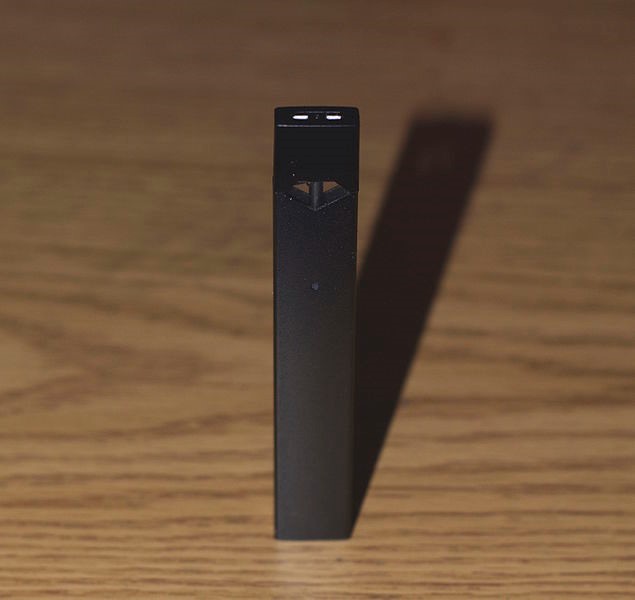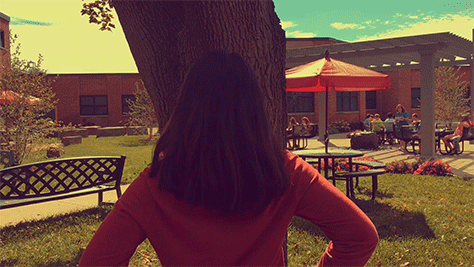School: A safe learning environment?
Photo Credit: Wikimedia Commons
A Juul is an e-cigarette that is very commonly used by teenagers. Its small size allows students to carry it around in their pockets without any adults noticing.
May 14, 2018
While seemingly innocent sixth grade students enjoy their lunch before heading outside for study lunch, there are other activities occuring in the high school bathrooms. Although it breaks school policies and laws, these bathrooms are locations where some students have gone to vape, especially during lunch.
Vapes heat up a liquid, most commonly containing nicotine, resulting in a similar high it would cause in its original form. These devices are small and easy to conceal, many look like other common items such as a USB flash drive, making them popular among teenagers.
But vaping is spreading to the middle school in the most unexpected environment: their classrooms. One dangerous new trend is the Juul, an extremely concealable e-cigarette.
Sixth grader James Jones* saw the vaping happening in his own classroom and during study lunch. He thinks teachers need to pay more attention to students, even during free periods.
A middle schooler faced consequences recently after being caught using a Juul, and there have also been similar cases in the past.
“All the bad stuff like vaping, drugs, and alcohol start in the high school, but I’ve come to the realization that it is coming closer to sixth, seventh and eighth grades,” another sixth grade student Jim Smith* said.
Studies show that 17 percent of students drink, use drugs, and smoke during the school day and more than one third said it is easy to do without getting caught.
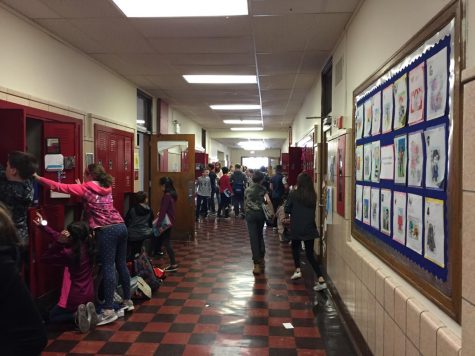
Sixth grade students take their items from their lockers at the end of the school day, rushing to finally go home. This year, one sixth grade student was caught using a Juul in class.
Smith said that a high schooler sold the Juul to the middle schooler. He said that the sixth grader was clueless to what he was really buying and the severe consequences it could cause.
“It can really affect it if the high schoolers come into the middle school, if their younger siblings are in the middle school, and they give them [drugs]..they could distribute it to their friends,” Smith said.
Most middle school students who have access to illicit products get them from their older siblings.
Juuls resemble a USB flash drive, which makes them easy to sneak into school. They are small devices that can be easily placed in pockets and backpacks. Previously, the bathrooms at the high school were locked to prevent unwanted behavior, but they have since reopened.
Each Juul pack of pods contains four capsules, which contain a 0.7mL of liquid, which has five percent nicotine by weight, approximately equivalent to one pack of cigarettes or 200 puffs. In other words, one pod is equivalent to smoking one pack of cigarettes.
“Many of these compounds are carcinogenic. Will they definitely cause cancer? We don’t know that, but it’s ordinarily not a good idea to put these compounds in your body,” said Norman Edelman, M.D., senior scientific advisor for the American Lung Association.
“I think it [the sixth grader’s use of Juul in class] was for attention and just curiosity,” Jones said.
Students are curious about devices like Juuls and other drugs. The intense highs they hear about from older kids are intriguing. They submit to peer pressure and end up partying too often and becoming addicted. Most people choose to ignore this issue, but it is important for adults, as well as students, to spread awareness about the consequences of drugs and alcohol.
“It’s sad that people have to start relying on that just to have, like, acceptance or feel like they can be friends with someone. Middle school is especially the time when people are impacted and influenced by others, so when they have alcohol or go to parties, it gets worse,” sophomore Stacy Jones* said.
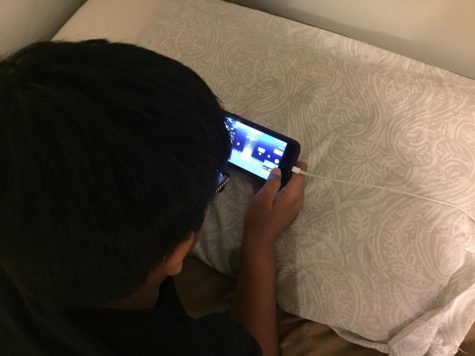
A student relaxes and enjoys free time after a long school day, by playing the popular game Fortnite, at his house. Students are often stressed by school and turn to Juuls or drugs to relax.
When middle school students see an older student use alcohol or drugs, they are immediately impacted in a negative way. No matter how many times kids are taught about the harmful effects of underage drinking or substance abuse, they often end up trying one of these things at least once. Sometimes, students have a difficult time accepting themselves and often need drugs or alcohol in order to feel accepted. Young people aged 12 to 20 consume 11 percent of all alcohol consumed in the United States, according to a survey conducted by The Recovery Village.
Peer pressure plays a substantial role in the increase of teenage drug and alcohol use. When making a decision, teens think about the consequences of their actions, but they often ignore the risks in favor of the rewards. Their decision can be influenced by who is around them, while they make a conscience stricken decision.
“If I saw my sister doing something bad, I probably would have a talk with her and make her realize what she’s doing and how it can impact her because it’s especially bad for her at her age and it can only get worse from there. I’d tell her to realize to accept herself without that stuff,” Jones said.
Middle schoolers consider high school students as role models, which means that some students follow what they do.
“I feel like they view us as role models and most of them have siblings in high school, so I feel like they aspire to be like us. I feel like they want to follow in our footsteps, and they want to experience things that we’ve experienced, like ‘oh when I’m in high school I’m eventually going to start doing that stuff, so I might as well start now,’” Jones said.
Social media also plays an important role in the growing drug and alcohol use amongst adolescents. They often see public figures vaping and drinking, which makes it feel like it is okay to use. Also, students often post pictures or videos of them drinking, dancing and partying on Snapchat and Instagram.
“On Snapchat especially since adults don’t have that or on their Instagram stories they will post that type of stuff because their parents won’t see it and if no one tells, no one will find out,” says Jones.
Professional volunteer, mom, and knockout opioid leader for Glen Rock, Michelle Torpey, says that it only takes one puff or one drink to start the path to addiction.
“Alcohol is a drug, pain medication is a drug and I think unfortunately for some kids it always takes one time,” Torpey said, “to be addicted.”
Torpey organized a drug collection box, a place to discard prescription drugs. She reached out to several local pharmacies and set up at Rock Ridge. She spent 900 dollars, but said it was it was worth it. Having a safe place to dispose of drugs prevents unnecessary use and the possibility of a child finding them.
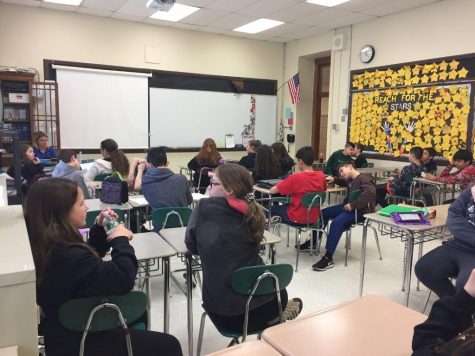
Middle School Health teacher Ms Gustray takes attendance during study lunch in the health room, where students learn about various issues, including drugs and alcohol.
The first time a person uses drugs, they will start to feel the effects immediately. The more often it is used, the higher one’s tolerance becomes, causing more intense and more frequent cravings.
Although the school has conducted several assemblies, inviting local police officers and parents of children who have overdosed, students still show an interest in use. Even the horrifying stories of mothers finding their sons unconscious in their rooms, fail to affect some students.
“I feel like the only way for teachers to listen is to bring in someone like our age who has dealt with this stuff and it has impacted them to talk about it. Kids don’t listen to adults as much cause they think that you’re like not cool or something,” Jones said.
Often, students cannot relate to adults because they feel they are being treated as inferiors.
In Glen Rock, students can attend LEAP Club meeting. Photo teacher, Ms. Dunay, organizes activities to help students destress.
The LEAP club organizes activities like color runs, game night and karaoke nights for students to enjoy.
“You guys are working so hard making that transition from elementary school to middle school. You’re in theatre and sports, and like that,” says Torpey. There should be more relaxing activities for students to enjoy, since there is so much stress that is placed on them with academics and sports.
If students need an adult to talk to in a safe space, student counselor Ms. Helder, is always available. She talks about social, family, and any other problems and help them develop solutions and coping skill.
Many teenagers choose to drink throughout high school so that they feel prepared for the parties they will see in college. Partying is a significant portion of many students’ college lives. Teens aren’t attracted to alcohol because of its taste, but rather its effects.
“I want to chug a beer until I pass out,” said one student while chatting to his peers.
When a student turns 16, they are eligible to receive their driving permit and older student have already gotten their licenses. They have cars which make them more independent. This situation can often be dangerous, as teens can drink and drive, which leads to fatal and deadly accidents. Drunk driving is one of the leading causes of death in the United States. Innocent civilians and other sober drivers on the road could also be seriously injured by drunk and reckless driving.
When a person is drunk, their brain is impaired and they often act in a way the would not if they were sober. This can cause rape, unplanned pregnancies, injuries, and other disasters.
Some people will do anything to be accepted in our generation, because the pressure is too much to handle and can cause them to eventually break. There are high standards for students, including getting good grades, participating in sports or other activities, and keeping up with their physical appearance.
Sometimes adults influence their own kids to drink or use drugs. Some parents do not care if their teenager drinks alcohol because they did it when they were in high school.
If parents are ignorant to what their children are doing, their children will take advantage of it. There have even been certain cases where some parents provide alcohol to the teenagers, which is considered a felony.
About 22.8 percent of adolescents report drinking by eighth grade, and about 46.3 percent report being drunk at least once by twelfth grade, reports a survey conducted by the National Institute on Alcohol Abuse and Alcoholism. Some parents cannot help their children when it comes to alcoholism and drug use.
Glen Rock is known as a very lively town with prestigious schools, but there are darker secrets hidden in this town among the teens. Some students claim that drugs can be obtained from the neighboring town of Paterson,or New York City. Some parents do not realize when their child is doing drugs or drinking constantly because teens have their own ways to hide symptoms and signs of being high and drunk.
When going to a party, teens sometimes tell their parents that they are going to a sleepover at their friend’s house. This way, they are not expected back to their houses. During the middle of the night, teens often sneak out of their house to go to parties.
For freshman, parties can be intimidating. Many freshman want to explore the party life and try new things, but, trying these new things can cause them to be in serious danger.
Many students over the past few years have had their stomach pumped because of the high alcohol content in their blood. This process is not only stressful, but also very scary for everyone. Other risks of partying include the police showing up.. This can lead to the owner of the house to be arrested, even if they are not home or do not know it is happening. There could be serious charges against the owner if someone gets injured or harassed.
Even though providing alcohol to minors is an obvious and serious crime, some parents still do it. Whether the parents want to feel more involved in their child’s life, there is no excuse to providing drugs and alcohol to minors.
“We know that alcohol and nicotine can affect how a teen’s brain develops. Use of these products alone or together can hard-wire the brain for addiction into their adult life,” said Susannah Burt, prevention program manager at the DHS Division of Substance Abuse and Mental Health.
For example, “About one-fourth of Utah youth who drank alcohol in the past 30 days reported that they also smoked conventional cigarettes,” said Karlee Adams, program manager for the UDOH Tobacco Prevention and Control Program.
Utah students in grades eight, 10, and 12 were more likely to report to drinking alcohol (22.3 percent) and e-cigarettes (23.1 percent) than conventional cigarettes (11.9 percent). More than 11 percent of students reported current e-cigarettes use, including alcohol use (8.8 percent), and cigarette smoking (2.9 percent).
Alcohol and drug use among teenagers can not only affect their own lives, but also that of their family and loved ones. Glen Rock is starting up new programs and activities that will help the residents and get over their addiction. Also, students are being taught the dangers of alcohol and drugs in school by professionals speaking in their health classes. Addiction takes a long time to get over, but people can overcome it and live a better life.



